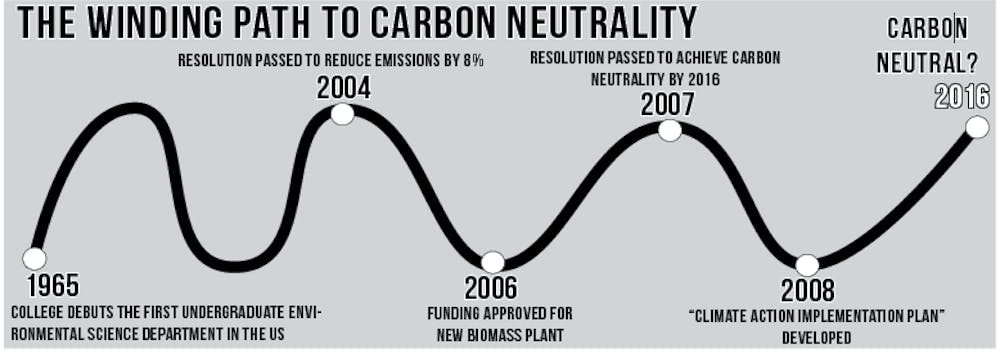In February 2015, a U.S. national security report called climate change “an urgent and growing threat to our national security.” Over the past two decades, climate change has become an increasingly important topic in the United States and across the world. Researchers have demonstrated the far-reaching effects of increasing levels of greenhouse gases and have pointed to more extreme weather patterns, such as the California drought and Hurricane Irene in Vermont, as signs of what is to come if climate change is not addressed. As issues involving climate change have risen to prominence, colleges and universities across the country have begun to develop more sustainable practices and promote conservation on their campuses.
In 2004, the College joined other leading higher-education institutions when the board of Trustees passed a resolution to reduce emissions by eight percent from 1990 levels by 2012. Then, in October 2006, the Trustees approved funding for a new biomass plant which would help the college achieve the eight percent emission reduction. In response to this development, students and faculty began advocating a new, more ambitious objective for the College: carbon neutrality. Thus, in 2007, amidst growing awareness about climate change and the effects of greenhouse gases on our atmosphere, the Board of Trustees approved a resolution to achieve carbon neutrality by 2016.
What is carbon neutrality? The fancy term you hear tossed around so often means net zero carbon emissions, achieved by balancing emissions with carbon sequestration and, usually as a last-ditch effort, by purchasing carbon credits.
To reach carbon neutrality, the College developed a “Climate Action Implementation Plan,” adopted on August 28, 2008. Focusing on areas like heating and cooling, electricity and transportation, the plan detailed several strategies for the College to reduce its footprint and shift toward carbon neutral energy sources. One of these strategies includes the construction of the new biomass plant, which reduced the College’s dependence on #6 fuel oil, and pursuing opportunities for renewable energy sources. In addition to suggesting alternative energy sources, the plan calls for efficiency upgrades of campus buildings in compliance with LEED guidelines.
Since the plan went into effect in 2008, the College has made progress in its quest for neutrality. In February 2014, Jack Byrne, the Director of Sustainability Integration, released an update stating the College’s carbon emissions for FY13 were 50% below 2007 baseline emissions. Byrne attributed this progress to the biomass plant and “numerous energy efficiency projects the College has completed over the past several years.”
Despite the College’s progress, it is not the first institution of higher education to approach carbon neutrality — not even the first in the NESCAC. In 2013, Colby College announced that it had achieved carbon neutrality, thanks in part to its own biomass plant. Colby College joined the ranks of three other small colleges, including Green Mountain College in Vermont, that have become carbon neutral.
Carbon neutrality remains an important goal for the College. When the class of 2016 arrived, they were touted as the “Carbon Neutral Class.” During their orientation, students learned about carbon neutrality and were encouraged to get involved with the initiative. Now, with the 2016 deadline drawing close and the Carbon Neutral Class nearing graduation, it is time to reflect on where we are. What has the College done to reduce its carbon footprint? What can still be done to improve the sustainability of the College? Every other week, this column will explore answers to these questions and more. Will the College actually be carbon neutral by 2016? The Carbon Countdown will help you decide.
Carbon Countdown: How Close Are We To Our Goal?

Comments


